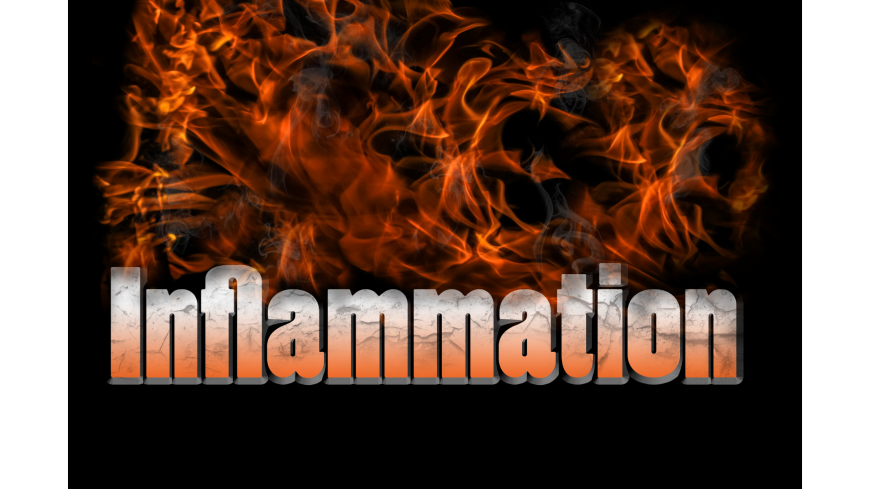Inflammation often gets a bad rap. But in truth, it’s actually an important and necessary part of our immune response and an essential part of our body system that alerts us, through a variety of possible symptoms, that something is wrong. It allows our body to repair and heal damaged tissue, and to defend itself against foreign invaders such as viruses and bacteria.
At one time or another, we have all suffered a visible injury, like a cut or a bruise, in which our body’s inflammatory response could actually be seen. We watched the healing happen before our eyes, as our painful injury turned red, maybe felt warm to the touch, and may have even become swollen as our white blood cells surrounded the injury area. But still, we rest assured, understanding this was the innate process our body deployed in order to repair the injury. In these instances, this type of ACUTE inflammation that starts quickly and helps the body heal itself is beneficial.
In contrast, CHRONIC inflammation happens when a prolonged inflammatory response occurs, which involves a progressive change in the type of cells present at the injury site. When this response lingers, it leaves our body in a constant state of alert, and over time, this can have a negative impact on our tissues and organs. This is the type of inflammation that is not beneficial and can wreak havoc on our bodies, oftentimes, unbeknownst to us until symptoms appear that become too big to ignore.
Signs of inflammation are like a fire alarm. They tell you that something is wrong. But your response is not to take the batteries out of the alarm, because that’s clearly not the problem. Instead, you need to look for the fire that caused the alarm to sound. It’s the same with inflammation. It tells you that there is a problem that needs to be addressed. Unfortunately, sometimes when these fire alarms have sounded, the flames have already taken over the whole house.
Since chronic inflammation is more impactful to our long-term overall health, it is important to be able to recognize the symptoms that result from it and address the root cause of these problems sooner rather than later.
Some common complaints of chronic inflammation include:
- Fatigue
- Anxiety/depression
- GI complaints
- Insomnia
- Body pain
- Weight gain or loss
- Persistent infections
- Skin disorders
- Reduced libido
It can also present as commonly known ailments such as cardiovascular disease, neurological disease, auto-immune disease, rheumatoid arthritis, lupus, fibromyalgia, and chronic fatigue syndrome.

Chronic Inflammation
As we age, the effects of chronic inflammation take a toll on our body. To reduce them, it is important to minimize the activities and behaviors that increase inflammation and increase the activities and behaviors that reduce it. Some of the inflammation-causing behaviors include things like a poor diet, smoking, and not getting enough sleep, whereas behaviors known for reducing inflammation include things like eating anti-inflammatory foods, getting regular exercise, and reducing stress where possible.
There are simple things you can do to reduce the impact of inflammation in your body. There are both natural/holistic solutions, like eating a diet rich in anti-inflammatory foods. It is important to remember that by addressing the underlying inflammation, you can reduce your symptoms and live a healthy life for the many years to come.
A study in the Journal of the American College of Cardiology, supported by the National Heart, Lung, and Blood Institute, (NHLBI) finds anti-inflammatory diets—those rich in colorful vegetables, fruits, and whole grains—may reduce the risk of cardiovascular disease.
Participants whose diets were rich in anti-inflammatory foods, including leafy green vegetables, such as spinach, broccoli, and kale; dark yellow vegetables, which included carrots, peppe rs, pumpkin, and beans; fruits, like berries; and whole grains, such as brown rice, had fewer incidents of cardiac-related events. Participants who ate higher proportions of pro-inflammatory foods, including red and processed meat, refined carbohydrates, ultra-processed foods, and sugary beverages, like soda, had an increased risk for heart attack, stroke, and coronary heart disease. These trends persisted after controlling for age, body weight, medical conditions, and smoking. The authors conclude altering inflammation in the diet, such as prioritizing foods naturally rich in vitamins, antioxidants, and fiber, may help reduce the risk for cardiovascular disease.
rs, pumpkin, and beans; fruits, like berries; and whole grains, such as brown rice, had fewer incidents of cardiac-related events. Participants who ate higher proportions of pro-inflammatory foods, including red and processed meat, refined carbohydrates, ultra-processed foods, and sugary beverages, like soda, had an increased risk for heart attack, stroke, and coronary heart disease. These trends persisted after controlling for age, body weight, medical conditions, and smoking. The authors conclude altering inflammation in the diet, such as prioritizing foods naturally rich in vitamins, antioxidants, and fiber, may help reduce the risk for cardiovascular disease.
Here are some terrific reading resources to dive deeper into inflammation and anti-inflammatory foods.
Sources:
https://jneuroinflammation.biomedcentral.com/articles/10.1186/s12974-020-01998-9
https://blog.lisahealth.com/blog/2021/8/20/menopause-and-inflammation
https://restorebalance.net/the-five-pillars-of-functional-medicine/
https://www.carolynwilliamsrd.com/blog-posts/category/Inflammation
https://blog.lisahealth.com/blog/2021/5/20/top-anti-inflammatory-foods-for-menopause







